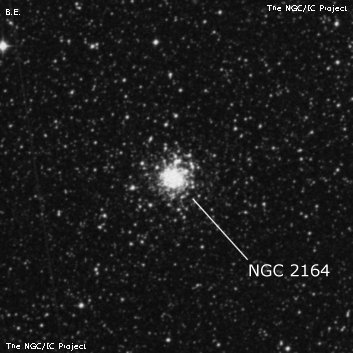
James Dunlop probably NGC 2164 = D 194 on 27 Sep 1826 and described a "A pretty large faint ill-defined nebula." His position is just 3' SW of this cluster. There are 3 other clusters within 9' (NGC 2156, 2159, 2172), but this is the largest and brightest. D 193, decribed by Dunlop as "pretty bright" is south of NGC 2159, but could also apply to NGC 2164.
John Herschel observed this cluster (h3011) on 5 sweeps beginning on 23 Nov 1834, first recording, "vB, R, gmbM; 90", resolvable." Herschel attributed Dunlop with the discovery. In 1926, Robert Innes described this object as "a very condensed cluster of stars with outliers, 11 to 15 mags." (26-inch refractor, Union Observatory).
600/800mm - 24" (4/11/08 - Magellan Observatory, Australia): this is the brightest of four clusters in a 10' field. At 260x it appeared very bright, large, round, sharply concentrated with an extremely bright core (appears to be a globular), the large outer halo extended to 2' diameter. Roughly 15 stars were resolved in the halo - some of these were easily resolved 14th mag stars, while others were quite faint. At 350x, two dozen stars were resolved and the core was very grainy. Overall, this is a very impressive cluster. NGC 2156 lies 6.8' NW, NGC 2159 is 8' SW and NGC 2172 is 9.7' SE..
Notes by Steve Gottlieb